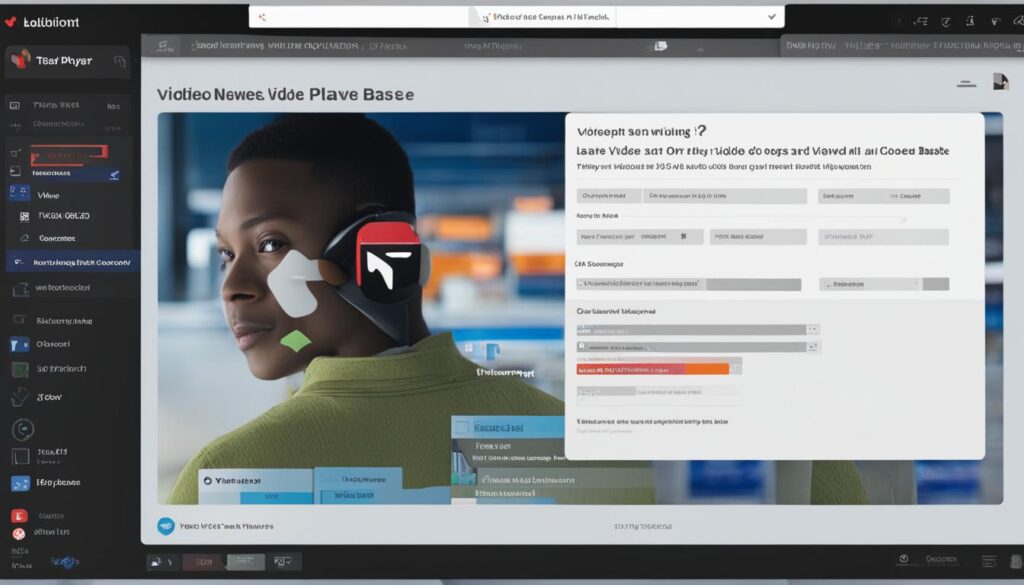Video is a powerful medium for conveying ideas and enhancing customer support. By incorporating a video knowledge base into your business strategy, you can provide a dynamic and engaging experience for your customers.
A video knowledge base offers numerous benefits and solutions for your organization. It enables you to deliver information in a more accessible and engaging format, increasing customer satisfaction and improving information retention. Whether you are looking for video knowledge base software, a comprehensive video knowledge base platform, or video knowledge base services, there are various tools and technologies available to meet your needs.
With a video knowledge base, you can leverage the power of NLP (Natural Language Processing) to enhance the search capabilities of your content, making it easier for customers to find the information they need. Additionally, video knowledge bases offer features such as closed-captioning, interactive elements, and analytics, allowing you to provide a seamless and immersive learning experience.
In this article, we will explore the benefits, features, and tools for creating a video knowledge base. Discover how to effectively use video in your knowledge base, gain insights into best practices for creating knowledge base videos, and learn about the challenges and solutions associated with implementing a video knowledge base. We will also introduce you to Floik, a leading tool that simplifies the process of creating and managing a video knowledge base.
When to Use Video in Your Knowledge Base
Video usage in a knowledge base can significantly enhance customer experience and support. Knowing when to incorporate videos into your knowledge base can make a substantial difference in engaging your audience and effectively conveying information.
Incorporating Video for Clear Demonstration
If your content is easier to show rather than describe, using video in your knowledge base is highly recommended. Videos can visually demonstrate complex processes, technical tasks, or intricate product features, making it easier for users to understand and follow along.
Maximizing Content Reach
Consider using video when the content is frequently visited or highly sought after. Videos can help attract and retain the attention of your audience, increasing engagement and information retention. Research even suggests that 69% of customers prefer learning about products and services through video rather than text.
Appealing to Emotions
Video has the power to create an emotional connection with your audience. By incorporating videos in your knowledge base, you can evoke emotions, capture attention, and instill trust. This can be particularly effective when promoting new releases, showcasing success stories, or presenting impactful testimonials.
Providing Evergreen Content
When your content changes infrequently, creating video tutorials or demonstrations can be highly beneficial. Videos can serve as enduring resources that provide consistent and reliable information, reducing the need for frequent updates.
Documenting Frequent Changes
Conversely, video can also be valuable when documenting frequent changes. Instead of continuously updating written content, video allows you to quickly showcase new features, demonstrate updates, and keep your knowledge base current.
By understanding the importance of video in a knowledge base and strategically utilizing it, you can enhance user experience, improve information retention, and optimize customer support.

| Benefits of Using Video in Your Knowledge Base | Importance of Video in Knowledge Base | Video Usage in Knowledge Base |
|---|---|---|
| Enhances customer experience | Facilitates clear demonstration | Improves information retention |
| Engages and captivates users | Maximizes content reach | Increases user engagement |
| Provides a more interactive learning experience | Appeals to emotions | Eases understanding of complex concepts |
| Reduces support tickets and inquiries | Offers evergreen content | Documents and showcases frequent changes |
How to Use Video in Your Knowledge Base
Video is a versatile tool that can be effectively incorporated into your knowledge base to enhance customer support and provide a more engaging learning experience. By understanding the different ways to use video, you can maximize its impact and create a valuable resource for your users.
Introduce Customers to Your Product or Service
One way to use video in your knowledge base is by creating introductory videos that provide an overview of your product or service. These videos can highlight key features, demonstrate how it solves customer pain points, and showcase the value it brings. By visually presenting your offering, you can capture the attention of your audience and generate interest in your solution.
Demonstrate How-To Processes
Video tutorials are an excellent way to guide customers through complex processes or explain step-by-step procedures. Whether it’s setting up an account, configuring settings, or troubleshooting common issues, video tutorials provide a visual walkthrough that is easier to follow than written instructions alone. By visually demonstrating the necessary steps, you can ensure clarity and help users accomplish their goals more effectively.
Create Excitement About a New Release
When launching a new product or feature, video can be a powerful tool to generate excitement and anticipation among your customers. Use video to showcase the benefits and unique aspects of the new release. By capturing the attention and curiosity of your audience, you can pique their interest and increase their desire to explore and engage with the new offering.
Walk Customers Through a Use Case
Showing customers how to get the most out of your product or service in real-world scenarios can be invaluable. By creating video walkthroughs of common use cases, you can guide customers through specific scenarios, provide tips and best practices, and address any potential challenges. These videos offer practical insights and help users understand how your offering can be applied to their specific needs.
Video tutorials in your knowledge base provide numerous benefits, including enhanced customer education, increased engagement, and a more visual learning experience. By incorporating video strategically, you can effectively convey information, simplify complex processes, and empower your users with the knowledge they need to succeed.

Tips for Creating Knowledge Base Videos
Creating effective knowledge base videos requires careful planning and attention to detail. Follow these tips and best practices to create compelling videos that engage your audience and provide valuable information.
1. Use Existing Content as Your Script
When creating knowledge base videos, start by using existing content as your script. This could include blog posts, FAQs, or documentation that already exists. By repurposing your content, you can ensure that the message remains consistent across different mediums.
2. Match the Audio to the Visuals
One of the keys to creating engaging videos is ensuring that the audio matches the visuals. Use clear and concise narration that complements what is happening on the screen. Pay attention to the pacing, tone, and volume of the audio to keep your viewers engaged.
3. Include Closed-Captioning for Accessibility
To make your knowledge base videos more accessible, include closed-captioning. Closed captions provide text that synchronized with the video, allowing viewers who are deaf or hard of hearing to follow along. Additionally, closed captions can also improve SEO by providing textual content for search engines to index.
4. Remember That Professional Editing Isn’t Always Necessary
While professional editing can enhance the quality of your videos, it’s not always necessary. Simple editing tools like Camtasia, Screencastify, and ScreenFlow can help you trim unnecessary footage, add captions, and adjust the audio. Don’t let a lack of professional editing skills deter you from creating valuable videos for your knowledge base.

5. Focus on Creating Quality Content
The most important aspect of your knowledge base videos is the content itself. Focus on creating high-quality content that is concise, informative, and aligned with your brand. Keep your videos focused and avoid unnecessary fluff or tangents that can distract your viewers.
“Quality over quantity. It’s better to have a few well-crafted videos that provide real value than a large number of mediocre videos.”
Incorporate these tips into your video creation process to create knowledge base videos that effectively educate and engage your audience.
Benefits of a Video Knowledge Base in SaaS Products
In the world of Software as a Service (SaaS), providing a comprehensive and interactive learning experience for customers is crucial for success. One powerful tool that can help achieve this is a video knowledge base. By incorporating videos into your knowledge base, you can unlock numerous benefits for your SaaS product and enhance customer satisfaction.
Enhance Customer Education
Video is a highly effective medium for educating customers about your SaaS product. Through visual demonstrations and tutorials, you can convey complex concepts in a simple and engaging manner. By presenting information in a video format, you can ensure that customers have a clear understanding of your product’s features and capabilities.
Boost User Engagement
Video content has a way of capturing and retaining users’ attention. By incorporating videos into your knowledge base, you can create a more engaging and interactive learning experience for your customers. This can lead to increased user satisfaction and a higher likelihood of customers fully utilizing and appreciating your SaaS product.
Improve SEO Results
Video content is highly favored by search engines, making it an excellent way to improve your website’s search engine optimization (SEO) results. By optimizing your video knowledge base with relevant keywords and metadata, you can enhance your online visibility and attract more organic traffic to your website. This can ultimately lead to increased brand awareness and customer acquisition.
Maximize Accessibility
A video knowledge base offers a more accessible learning experience for customers of all abilities. By providing closed captioning and transcripts for your videos, you can ensure that individuals with hearing impairments can fully comprehend the content. Additionally, visual learners may find video tutorials more intuitive and easier to follow than traditional text-based guides.
Provide Insights for Content Optimization
Analyzing the performance of your video knowledge base can provide valuable insights for optimizing your content. By tracking metrics such as video views, watch time, and user feedback, you can identify which topics are resonating with your customers and make data-driven decisions for future video creation. This iterative process allows you to continuously improve the quality and relevance of your knowledge base content.
Increase Customer Support Efficiency
By offering a video knowledge base, you can reduce the reliance on traditional customer support channels for addressing common queries and issues. Videos can provide self-service solutions that empower customers to troubleshoot problems on their own. This not only improves customer satisfaction by providing instant support, but it also frees up your support team to focus on more complex matters.
Overall, incorporating a video knowledge base in your SaaS product can revolutionize the way your customers learn and interact with your offering. From enhancing education and engagement to improving SEO results and customer support efficiency, the benefits of a video knowledge base in SaaS products are undeniable.

| Benefits of a Video Knowledge Base in SaaS Products |
|---|
| Enhance Customer Education |
| Boost User Engagement |
| Improve SEO Results |
| Maximize Accessibility |
| Provide Insights for Content Optimization |
| Increase Customer Support Efficiency |
Challenges of Creating a Video Knowledge Base
While implementing a video knowledge base can bring numerous benefits, there are several challenges that organizations may encounter throughout the creation process. Overcoming these obstacles is crucial to ensure the successful integration of video content into your knowledge base.
1. Time and Resources
Creating video content requires a significant investment of time and resources. From planning and scripting to filming and editing, each step demands careful attention and expertise. Organizations must allocate sufficient resources and determine an effective workflow to manage the creation of high-quality videos.
2. Language and Accessibility
When catering to a diverse audience, language and accessibility challenges can arise when creating videos. Translating content into multiple languages and providing closed captions or subtitles can be complex tasks. It is essential to consider accessibility standards and provide appropriate accommodations to ensure inclusivity.
3. Technical Expertise
Editing video content requires technical expertise in video editing software, such as Adobe Premiere Pro or Final Cut Pro. Organizations may need to invest in training or hire professionals with video editing skills to ensure the creation of seamless and professional-looking videos.
4. Measuring Effectiveness
Measuring the effectiveness of video knowledge base content can be challenging. Unlike text-based articles, it may be more difficult to track engagement, view duration, or identify areas where users drop off. Implementing analytics tools specifically designed for video content can help provide insights on viewer behavior and optimize video performance.
5. Hosting and Distribution
Once videos are created, organizations need to determine the best method for hosting and distributing them. Balancing factors such as video quality, loading time, and bandwidth utilization is essential to ensure a seamless viewing experience for users. Additionally, organizations should choose a secure and reliable hosting platform to protect their videos.
6. Content Updates
As products evolve or new features are introduced, maintaining up-to-date videos can be a time-consuming task. Frequently updating videos to reflect the latest information requires additional time and resources. Organizations must establish a process for keeping video content relevant and accurate amid product changes.
Creating a Video Knowledge Base with Floik
Floik is the ultimate tool for simplifying the process of creating a video knowledge base. With Floik, you can effortlessly record high-quality audio and add closed-captioning to ensure accessibility for all users. Take advantage of interactive elements that engage viewers and track video analytics to gain valuable insights.
Floik provides an intuitive editor that allows you to easily create, edit, and publish your video content. Whether you’re a novice or an experienced video creator, Floik’s user-friendly interface makes the entire process seamless. Plus, with its robust set of features, you have full control over branding, collaboration, voiceover, transcribing audio, and content management.
With Floik, teams can collaborate efficiently and create professional video content in a scalable and cost-effective manner. Whether you’re looking to enhance customer education, boost user engagement, or provide comprehensive tutorials, Floik has got you covered.
Experience the power of Floik and revolutionize your video knowledge base creation today!
Video Knowledge Base Showcase: Top 10 Examples to Inspire You
Looking for inspiration to create your own video knowledge base? Explore these 10 examples of video knowledge bases from companies like Floik, IKEA, Intercom, and HubSpot. Each showcase demonstrates how video can be leveraged to enhance customer support, educate users, and provide comprehensive tutorials.
1. Floik’s video knowledge base showcases their intuitive editor, allowing users to create, edit, and publish high-quality video content. They emphasize features such as branding, collaboration, and video analytics, making it a top choice for professional video creation.
2. IKEA’s video knowledge base offers step-by-step video tutorials on assembling their furniture. With clear visuals and instructions, they educate customers on how to easily put together their products.
3. Intercom’s customer support video knowledge base focuses on providing quick and informative video tutorials. Their videos cover a wide range of topics, helping users troubleshoot and optimize their Intercom experience.
4. HubSpot’s video knowledge base showcases their comprehensive library of video resources. They cover various topics related to marketing, sales, and customer service, providing valuable insights and best practices.
By exploring these examples, you can gain ideas on how to create your own effective video knowledge base. Take inspiration from their approach to customer support, educational content, and tutorial videos to enhance your own knowledge base.
FAQ
What is a video knowledge base?
A video knowledge base is a platform or software that utilizes video content to provide information, tutorials, and support to users. It enhances customer education, engagement, and accessibility.
When should I use video in my knowledge base?
Video is best used in a knowledge base when the content is easier to show than to describe, the content is frequently visited, you want to create an emotional reaction, the content changes infrequently, or you’re documenting frequent changes.
How can I use video in my knowledge base?
There are several ways to use video in a knowledge base. You can introduce customers to your product or service, demonstrate how-to processes, create excitement about a new release, and walk customers through a use case. Video tutorials can enhance customer education and engagement.
What are some tips for creating knowledge base videos?
When creating knowledge base videos, it’s important to use existing content as your script, match the audio to the visuals, include closed-captioning for accessibility, and focus on creating quality content that is concise and aligned with your brand.
What are the benefits of a video knowledge base in SaaS products?
A video knowledge base can enhance customer education, boost user engagement, improve SEO results, maximize accessibility, provide insights for content optimization, and increase customer support efficiency.
What are the challenges of creating a video knowledge base?
Creating a video knowledge base can be time-consuming and require resources. Language and accessibility challenges can arise when creating videos for a diverse audience. Technical expertise may be required for editing video content. Measuring the effectiveness of video knowledge base content and hosting and distributing videos can also present challenges.
How can I create a video knowledge base with Floik?
Floik is a tool that simplifies the process of creating a video knowledge base. It allows users to record high-quality audio, add closed-captioning, include interactive elements, and track video analytics. Floik provides an intuitive editor for creating, editing, and publishing video content. It offers features for branding, collaboration, voiceover, transcribing audio, and managing content.
Can you provide examples of video knowledge bases?
Sure! Here are 10 examples of video knowledge bases to inspire you: Floik, IKEA, Intercom, HubSpot, Salesforce, Slack, Zendesk, Trello, Asana, and Dropbox. These companies effectively use video to enhance customer support, educate users, and provide comprehensive tutorials.
